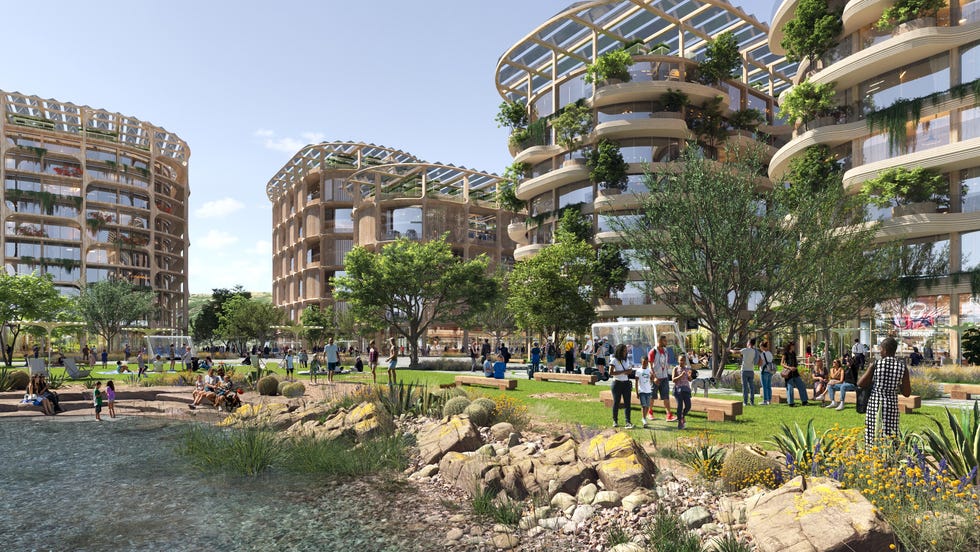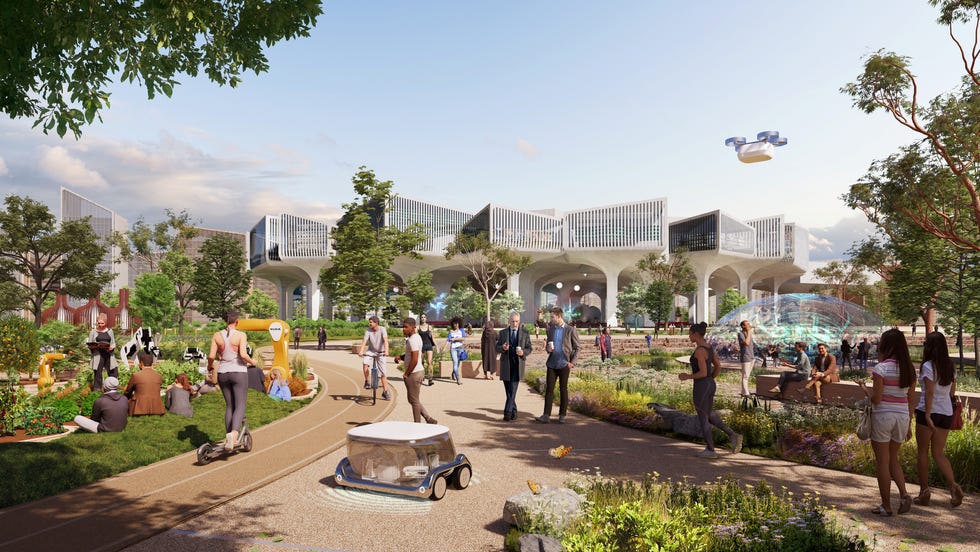Billionaire Marc Lore outlines how he will build the inclusive, Utopian desert city Telosa
Marc Lore grew up wanting to be a farmer – reveling at the idea of "something growing from nothing" – all while watching his father unafraid to take chances with ambitious business ventures.
The 50-year-old billionaire developed his appetite for taking risks from his father, Peter, and it's that foundation in childhood that's propelling him to now focus on a spellbindingly ambitious endeavor that many experts and pundits are deeming near impossible.
Lore, the former president of Walmart e-commerce and co-founder of Jet.com and Diapers.com, is attempting to spearhead the conceptual and financial building blocks for Telosa, a Utopian city in the middle of the desert announced last month.
Telosa's location is being targeted in the American West desert or Appalachia with plans to shepherd in a reformed version of capitalism with a focus on societal inclusion over division. Lore envisions Telosa having equal access health care, excellent schooling and safe environments for families, regardless of income. Even further, he aims for Telosa to be a diverse place housing various races, genders, sexual orientations, religions and political affiliations.
But exactly how the "city of the future" is built is both risky and complicated. Experts and researchers have long maintained that too many financial hurdles can stand in the way, with one 2014 study arguing that "the ability of eco-cities to achieve their utopian ambitions may be limited by the realities of operating within a profit-driven, entrepreneurial planning environment."
Yet that's where Lore feels like Telosa can be different, and understanding the colossal "how" of the project means understanding the "why" for Lore.
Marc Lore:Former Walmart president reveals plan for $400-billion Utopian city in the US desert
Telosa's name derives from the Ancient Greek word telos – meaning "higher purpose." Conceptual art of Telosa looks like it's pulled from a science fiction movie. Nearly everything appears fueled by solar power energy, autonomous electric cars and high-speed public transportation. Designs from architectural firm Bjarke Ingels Group (BIG), the same company that created Google's headquarters, shows 150,000 acres of eco-friendly architecture, including a beacon-esque skyscraper known as the "Equitism Tower."
The headlines of Telosa last month honed in on the $400 billion objective that will take massive buy-in from key investors to even get the project off the ground. Factor in Lore's lofty goals that start with a first phase of 50,000 living residents to be welcomed into the city by 2030, and the public skepticism is hardly hidden.
That's not lost on Lore, who sees the attempt – similar to those of his father growing up – just as important as the end goal.
"I'm not pursuing this to make money," said Lore, a co-owner of the NBA's Minnesota Timberwolves. "I'm doing this because of what it can mean for others and the future. If this entire attempt doesn't work, then hopefully there are things to learn from itand it will inspire others to take their shot."
A 'global standard for living'
Lore is cognizant of the optics that can come from attaching his name – and value system – to a city starting from the ground up.
But the entrepreneur said his role is mostly to provide a placeholder for the people to create the city's culture themselves. Telosa's official website promotes future residents always being connected to community and nature while setting a "global standard for living" with the goal of expanding "human potential."

"I don't want to be the ruler of the city; this is more of a public service," Lore said. "I'm wanting to give it a place to grow and flourish. It's not meant to be a private city; it's meant to be a city for everyone – with an innovative way we live."
Lore calls his model "equitism" and it would allow any Telosa citizen to build their home and sell it, while the city would retain ownership of the land that's underneath. By that set-up, in a dream scenario, Lore believes Telosa's desert land would eventually balloon in value to be worth $1 trillion. Lore said that land value, which could come out to $50 billion from investments and endowments, would go directly toward the city's funding to ensure that every family has equal access to health care, good schooling and a safe environment, regardless of income.
Top-down economic models present complications, but they've been achieved elsewhere. The concept of community-owned land on a large scale is on display in Singapore, where the government owns 90% of the country's land and then the proceeds are reinvested in the country. While there's skepticism, Lore's hope is to provide a blueprint for other future cities, noting that so many U.S. cities today have become ingrained in politics where bridges of trust have been fractured over time.
"The sole purpose of creating a city in the desert would be so it's owned by the community, basically take all the appreciation of the land and give it back to the citizens," Lore said. "Taxes paid will go back to the city for infrastructure – roads, tunnels and bridges – so everyone would know exactly where their money is going.

How does someone become a resident of Telosa?
The selection process for the first 50,000 in Telosa is yet to be determined but will likely be done by application. One thing Lore can promise is that inclusion of varying races, genders, sexual orientations and religions will be a top priority.
Still, selection could be one of the tallest hurdles for Telosa from a public perception standpoint. Simply naming qualifications for citizens can have a discriminatory connotation. One lure to draw people to Telosa will be a Lore-created venture capital fund that could house startups that relocate to the city. But what will the other careers of first citizens be?
"We can't create a city without some early nudging to move to the city," Lore said. "We'll have to kickstart in an unconventional way, but the hope is we'll position the people to grow a culture."
Lore said much of the framework for the first "settlers" will be sorted out with aid from his team of 50 volunteers and full-timers made up of architects, historians, researchers, economists, creatives, designers, engineers and climate experts.

Once the first phase begins in 2030, Lore said the hope of the equitism model is to let the people drive the creation of the city's culture and then accentuate the diversity through respect and an equal value system.
"How does a city have a soul?" Lore said. "It's not about buildings and roads, it's about the values and the city standing for something. We don't know what that is yet, but we want to find out."






No comments:
Post a Comment